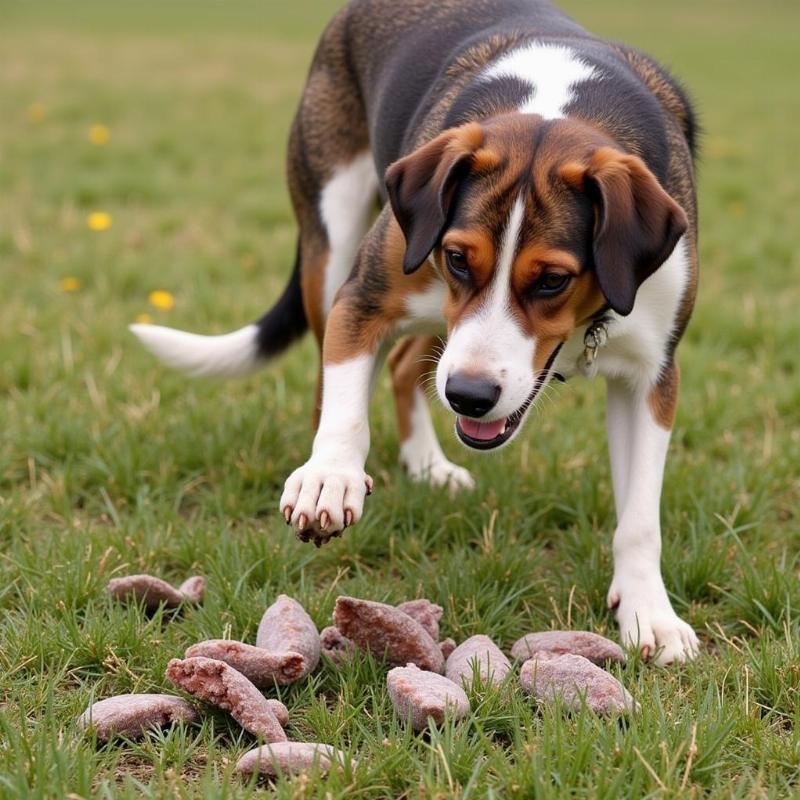Frozen birds, specifically quail, pheasant, and duck, offer a unique and effective way to enhance your dog’s training regimen. Whether you’re working on scent work, recall, or simply adding a new level of engagement to your sessions, frozen birds can be a valuable tool. They provide a realistic and stimulating reward that taps into your dog’s natural instincts. This comprehensive guide will explore the benefits of using frozen birds for dog training, discuss proper handling and safety measures, and provide practical tips for incorporating them into your training routine.
Why Use Frozen Birds for Dog Training?
Traditional dog treats, while convenient, often lack the excitement and stimulation that frozen birds can provide. The scent and texture of real game offer a high-value reward that can significantly increase your dog’s motivation and focus. This is especially beneficial for scent work training, where the goal is to develop and refine a dog’s ability to detect and follow specific odors. Furthermore, frozen birds can be a healthier alternative to processed treats, offering a natural source of protein and other essential nutrients. They are also a great option for dogs with allergies or sensitivities to certain ingredients found in commercial treats.
For recall training, frozen birds can be a game-changer, particularly for dogs who tend to wander or become distracted. The potent aroma acts as a powerful lure, enticing your dog to return quickly and reliably, even from a distance. This is crucial for ensuring your dog’s safety and maintaining control in various environments.
Safe Handling and Preparation of Frozen Birds
While frozen birds offer many benefits, proper handling is essential to prevent bacterial contamination and maintain food safety. Always thaw birds in the refrigerator, never at room temperature. This slow thawing process helps minimize the risk of bacterial growth. Once thawed, avoid refreezing. Handle thawed birds as you would any raw meat, washing your hands thoroughly after handling and cleaning any surfaces that come into contact with the bird.
Incorporating Frozen Birds into Your Training Routine
Start by introducing the frozen bird as a high-value reward during training sessions. You can use small pieces as rewards for successful completion of commands or desired behaviors. For scent work, hide the bird or pieces of it for your dog to locate. For recall training, use the bird as a lure to encourage your dog to return to you. Gradually increase the distance and distractions as your dog progresses.
Choosing the Right Frozen Bird
Different frozen birds have varying sizes and scents. Quail are a good starting point for smaller dogs or for initial training. Pheasant and duck offer stronger scents and larger sizes, suitable for more advanced training or larger breeds. Consider your dog’s size, training goals, and preferences when selecting the appropriate bird.
 Dog Training with Frozen Pheasant
Dog Training with Frozen Pheasant
Conclusion
Frozen birds can be a valuable addition to your dog training toolkit, offering a natural, stimulating, and highly motivating reward. By following safe handling practices and incorporating them thoughtfully into your training routine, you can enhance your dog’s learning experience and achieve significant training progress. Remember to choose the right bird for your dog’s size and training goals, and always prioritize safety and hygiene. Frozen birds are a fantastic way to tap into your dog’s natural instincts and strengthen your bond through engaging and rewarding training sessions.
FAQ
- Can I feed my dog frozen birds every day? While frozen birds are a healthy treat, they should be used in moderation as part of a balanced diet.
- What if my dog doesn’t like frozen birds? Some dogs may need time to adjust to the new scent and texture. Try offering small pieces initially or mixing the bird with a familiar food.
- Are frozen birds suitable for puppies? Yes, but ensure the bird is thawed and cut into small, manageable pieces to prevent choking hazards.
- Where can I purchase frozen birds for dog training? Specialty pet stores, online retailers, and some local butchers offer frozen game birds suitable for dog training.
- How should I store frozen birds? Store frozen birds in a sealed container in the freezer until ready to thaw and use.
- Can I use cooked birds for training? Cooked birds can be used, but ensure they are plain and without any added seasonings or oils.
- What are the best bird species to use for dog training? Quail, pheasant, and duck are popular choices, offering a range of sizes and scents.
Beautdogs.us is your premier source for expert advice on all things dog-related. We offer comprehensive resources on dog breeds, care, training, and product recommendations tailored to the American dog owner. Whether you’re a seasoned pet parent or just starting your journey, Beautdogs.us is here to support you. Connect with our experts at [email protected] or call us at +1 501-555-7529. Visit Beautdogs.us for more valuable insights and to elevate your dog’s life!